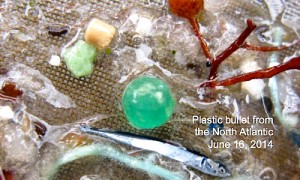Microplastics in the Sea Water and Plastics Everywhere
From the Article by Kara Law and Richard Thompson, Science:
Vol. 345 no. 6193 pp. 144-145, July 11, 2014
Department of Oceanography, Sea Education Association, Woods Hole, MA and School of Marine Science and Engineering, Plymouth University, Plymouth UK
Plastics litter beaches and the open ocean. Scientists are increasingly concerned about a less visible form of plastic pollution: microplastics. Microplastics arise from the deterioration of larger plastic items and from microbeads used in cosmetics. In their Perspective, Law and Thompson explain that because marine currents distribute the pollutants in unpredictable ways, trends in microplastic pollution are difficult to measure. Microplastics can contain harmful chemicals and may also release toxic additives used in their manufacture. They are ingested by and can poison many marine organisms. We are currently unable, and may never be able, to remove microplastics from the oceans. We thus need to understand the environmental effects of this major pollutant in the hope of mitigating its worst effects.
Plastic debris in the marine environment is more than just an unsightly problem. Images of beach litter and large floating debris may first come to mind, but much recent concern about plastic pollution has focused on microplastic particles too small to be easily detected by eye. Microplastics are likely the most numerically abundant items of plastic debris in the ocean today, and quantities will inevitably increase, in part because large, single plastic items ultimately degrade into millions of microplastic pieces. Microplastics are of environmental concern because their size (millimeters or smaller) renders them accessible to a wide range of organisms at least as small as zooplankton, with potential for physical and toxicological harm.
>>>>>>>>>>>>>>>>>>>>>>>>>>>>>>>>>
Research Institute Finds Plastic in Every Ocean Sample From Bermuda to Iceland, from EcoWatch.com, July 3, 2014
A crew of 14 scientists, filmmakers, journalists and others successfully sailed from Bermuda to Iceland and found exactly what they were looking for—an astounding amount of plastic on oceanic floors.
The group gathered by the 5 Gyres Institute reached Iceland earlier this week after a three-week, plastic-pollution research voyage across the North Atlantic and sub-polar Gyres. Simply put, the researchers found microplastic particles in every surface sample collected during the trip, which spanned 2,500 nautical miles.
“As we’ve seen in our other expeditions across the five subtropical gyres or ‘garbage patches,’ plastic pollution is ubiquitous in the world’s oceans,” said Dr. Marcus Eriksen, 5 Gyres co-Founder, research director, expedition leader and principal investigator.
“Even in the subpolar gyre, which contains far less plastic than other regions we’ve surveyed, we’re still finding particles in every sample. Plastic pollution is the new baseline for our ocean environment.”
The Institute hopes its findings will lead to change just like a previous expedition that lead to the “Ban the Bead” campaign and voluntary microbead phase-outs from Johnson & Johnson, Procter & Gamble and other companies used the tiny beads in cosmetic products. Earlier this month, the State of Illinois announced a ban on the manufacturing and sale of products containing microbeads.
“Every sample of ocean water we’ve collected is riddled with plastic,” said Allison Cook, director of engagement for The Story of Stuff Project and expedition participant. “I’ll admit that the tiny plastic pieces are not particularly impressive on their own. Yet, when I think about how vast this ocean is and how small a path we are traversing, the consequences of all of those tiny bits of plastic boggle the mind and deflate the spirit.”
The group has also been studying the subsurface distribution of microplastics, the impact of plastics on foraging fish and testing new collection equipment at sea.
“Research is costly at sea. When we have the opportunity to do our work, I seek collaborations with the global scientific network, collecting samples for my colleagues who concentrate on related fields of study to plastic pollution,” Eriksen said. “With these partnerships, we can further our scientific understanding of plastic pollution while managing the costs associated with data collection in the most remote parts of the world.”


{ 2 comments… read them below or add one }
NOTE: A gyre is a swirl or vortex, as in gyration.
So the famous limerick can be rewritten thusly:
Large gyres have small gyres
that feed on their velocity
And small gyres have micro gyres
and so on to viscosity
Unfortunately, all gyres have microbeads
and so on to a polluted planet!
White and wonderful? Microplastics prevail in snow from the Alps to the Arctic
Melanie Bergmann1,*,†, Sophia Mützel1,†, Sebastian Primpke1, Mine B. Tekman1, Jürg Trachsel2 and Gunnar Gerdts1
1Alfred-Wegener-Institut Helmholtz-Zentrum für Polar- und Meeresforschung, Am Handelshafen 12, Bremerhaven 27570, Germany.
2WSL Institute for Snow and Avalanche Research SLF, Flüelastrasse 11, 7260 Davos Dorf, Switzerland.
Science Advances 14 Aug 2019:
Vol. 5, no. 8, eaax1157
DOI: 10.1126/sciadv.aax1157
Abstract
Microplastics (MPs) are ubiquitous, and considerable quantities prevail even in the Arctic; however, there are large knowledge gaps regarding pathways to the North. To assess whether atmospheric transport plays a role, we analyzed snow samples from ice floes in Fram Strait. For comparison, we investigated snow samples from remote (Swiss Alps) and populated (Bremen, Bavaria) European sites. MPs were identified by Fourier transform infrared imaging in 20 of 21 samples. The MP concentration of Arctic snow was significantly lower (0 to 14.4 × 103 N liter−1) than European snow (0.19 × 103 to 154 × 103 N liter−1) but still substantial. Polymer composition varied strongly, but varnish, rubber, polyethylene, and polyamide dominated overall. Most particles were in the smallest size range indicating large numbers of particles below the detection limit of 11 μm. Our data highlight that atmospheric transport and deposition can be notable pathways for MPs meriting more research.